
|
 |
|
Last Updated: Aug 28th, 2006 - 01:36:21 |

2006 CADILLAC STS-V: SUPERCHARGED ELEGANCE
New 440-horsepower Supercharged Northstar V-8 Engine
New Hydra-Matic Six-Speed Automatic Transmission
Chassis Tuned for the Track or Autobahn
Exterior Design Combines Elegance, Performance, Functionality
Leather-Wrapped, Performance-Refined Interior
| DETROIT - The 2006 Cadillac STS-V is General Motors' most intense expression of Cadillac power and performance yet, and the luxury nameplate's latest offering in its growing family of high-performance V-Series vehicles. The STS-V carries all the craftsmanship and sophistication of its STS sibling, but does so at an entirely different level. Designed for everyday driving, the STS-V has been developed to deliver supercharged, rear-drive performance with an elegant design statement that is unmistakably Cadillac.
At the heart of the STS-V is a new, 4.4-liter version of the Northstar engine outfitted with a positive displacement intercooled supercharger. The dual overhead cam (DOHC) V-8 engine delivers the highest horsepower rating of any production Cadillac engine to date. Called the Northstar V-8 SC (supercharged), the engine produces 440 horsepower (328 kW) at 6400 rpm and 430 lb.-ft. (583 Nm) of torque at 3600 rpm (power and torque figures estimated) - and the engine's power is underscored by its ability to deliver 90 percent of its peak torque between 2200 and 6000 rpm. Vehicle redline is 6700 rpm. The Northstar V-8 SC generates 120 horsepower (90kW) and 115 lb.-ft. (156 Nm) of torque more than its naturally aspirated counterpart, while its specific output of 100-horsepower-per-liter makes it one of the world's highest specific output production V-8 engines. However, the Northstar V-8 SC used in the STS-V is more than just power and torque. The DOHC engine includes variable valve timing that enables outstanding top-end performance while maintaining the expected refinement and quality associated with a luxury marque. The aggressive torque curve enabled by the choice of a supercharged engine gives the STS-V acceleration capable of placing it firmly in the under-5-second-club for 0-to-60 time. The refined shift feel is enabled by careful electronic calibration of both the engine and transmission. During shifts, power is instantaneously lowered, then ramped back up carefully to make gear changes virtually unnoticeable.
The Northstar V-8 SC is mated to the all-new Hydra-Matic 6L80 six-speed automatic transmission - the first use of GM's new six-speed automatic. The 6L80 - the only transmission offered on the STS-V - is one of the most technologically advanced automatic transmissions in the industry, using clutch-to-clutch operation and an advanced integrated 32-bit transmission controller to deliver smooth and precise shifts. The 6L80 also incorporates a host of advanced driving enhancement features, including advanced Performance Algorithm Shifting (PAS) and Driver Shift Control (DSC). PAS lets the electronic transmission controller override the automatic gear selection during closed throttle high lateral acceleration maneuvers, rapidly downshifting with the release of the torque converter clutch for smooth powering up when the throttle is reopened. Driver Shift Control allows the driver to sequentially shift gears manually via the gearshift lever.
The STS-V has been tuned for performance on virtually every road condition and environment including GM's all-new Milford Road Course facility and the Nordschleiffe (North Course) at Nόrburgring. As a result of this extensive development, the vehicle has track-capable acceleration, braking and cornering abilities. This is due, in part, to increased tire sizes (P255/45R18 front, P275/40R19 rear); increased brake rotor diameters, larger pad areas, and larger calipers; increased stiffness stabilizer bars and suspension springs; a faster steering ratio; and chassis tuning aimed at delivering high performance without punishing the driver.
Exterior elements on the STS-V enable higher-performance capabilities; yet express the sophisticated elegance associated with the STS name. Exterior refinements include:
A larger, polished stainless steel wire mesh front grille that enables the required additional airflow for engine heat dissipation. The wire mesh grille not only signifies the sedan as a V-series, but is also a heritage cue - wire mesh grilles were applied on the Cadillac V-16, the standard bearer of luxury and performance in the 1930s;
A new, lower front fascia that incorporates a larger lower grille (also wire mesh) for increased cooling capability; brake ducts for front caliper and rotor cooling; and splitter to counteract lift created by larger grille openings;
A new lower rear fascia that facilitates smooth airflow under the vehicle for improved cooling;
Lower rockers that visually bridge the lowered front and rear fascias;
A specific, fluidly sculpted hood designed to provide space for the engine's supercharger;
Ten-spoke, flangeless, painted aluminum alloy wheels that assist in brake cooling. Front wheels are 18 x 8.5 inches; rear wheels are 19 x 9.5 inches;
A higher, more rearward-positioned rear spoiler that enables balanced aerodynamic downforce with the front splitter; and
V-series badging prominently displayed on the vehicle's rear decklid and front doors along with "Supercharged" block lettering on the doors.
The interior of the STS-V reflects craftsmanship with the addition of more leather-wrapped surfaces to promote a high-quality, tactile feel and distinctive, crafted appearance. Interior refinements include:
Hand-wrapped leather surfaces throughout;
Olive Ash Burl wood appointments;
Kinetic-finished aluminum accents;
Sueded fabric seat inserts;
V-series badging in the instrument cluster, on the instrument panel, and on door sill plates; and
A new Tango Red color accent offering that is applied on seat inserts (front and rear), console, center armrest, lower instrument panel and door mid-sections (front and rear).
With three million subscribers, OnStar is the nation's leading provider of in-vehicle safety, security and information services using the Global Positioning System (GPS) satellite network and wireless technologies. The 2006 STS-V will offer OnStar's Gen 6.1 system. With Gen 6.1, GM OnStar subscribers can interact with OnStar's voice recognition system in Spanish, French or English. With the push of a button an OnStar advisor can change the system to allow the subscriber to interact with the system in their preferred language. Other core OnStar services are stolen vehicle location assistance, remote door unlock, roadside assistance, emergency services and automatic crash notification.
GM is the only automotive manufacturer committed to offering a full range of vehicles with safety protection before, during and after a collision. All OnStar-equipped vehicles come with Automatic Crash Notification. If air bags deploy, the system sends a signal to a highly trained OnStar Emergency Advisor, who contacts the vehicle to see if help is needed, and can contact an emergency responder to send for help. In many cases the occupants are severely injured and cannot speak for themselves. OnStar's GPS unit allows Advisors to tell emergency responders the vehicle's location. OnStar responds to at least one air bag deployment in the US or Canada every hour.
Additionally, the 2006 STS-V will offer the GM-exclusive Advanced Automatic Crash Notification system. The AACN system detects collisions, even rollovers, regardless of whether air bags deploy. AACN also transmits other crash data, such as the direction of impact force, the number of and which air bags deployed and the maximum change of impact velocity, so that emergency responders are more prepared with this critical information before they arrive at the accident scene.
The STS-V was engineered and executed by GM's Performance Division, an in-house center designed to explore potential enthusiast-oriented versions of production models. No engineering, design or assembly functions were outsourced - the vehicle is truly an original equipment offering. Like its STS sibling, the STS-V will be built at GM's state-of-the-art Lansing Grand River (LRG) assembly center beginning in 2005. In 2004, the LGR facility received JD Power's highest award for plant quality in North America.
The STS-V is expected to arrive in Cadillac showrooms in the fourth quarter of 2005.
Watch the STS-V tearing up the track (.MOV)

2006 Cadillac STS-V
Technical and Mechanical Specifications
Overview
|
Model: |
2006 Cadillac STS-V |
|
Body style / driveline: |
luxury 4-door high-performance sedan with rear-wheel-drive |
|
Construction: |
unitized welded steel body with direct-mounted front cradle and rubber-isolated, multi-link independent rear suspension assembly |
|
Manufacturing location: |
Lansing Grand River Assembly, Lansing, Michigan |
|
Key competitors: |
BMW M5, Mercedes Benz AMG E55 |
Engine 2006 Northstar V-8 SC
|
Configuration: |
supercharged 4.4L DOHC V-8 |
|
Installation: |
longitudinal RWD |
|
Bank angle: |
90-degrees |
|
Displacement (cu in / cc): |
267 / 4371 |
|
Bore & stroke: |
91 mm x 84 mm |
|
Bore spacing: |
102 mm |
|
Engine mass (lb / kg): |
506.4 / 229.7 |
|
Block material: |
upper sand-cast 319 T7 aluminum
lower die-cast aluminum |
|
Cylinder head material: |
319 T7 semi-permanent mold cast aluminum alloy |
|
Supercharger / intake: |
GM patented integral design, GM specific helical roots rotor set, cast aluminum case, four integrated tubular (Laminova style) intercoolers |
|
Exhaust manifold material: |
cast nodular iron |
|
Crankshaft material: |
forged steel with rolled fillets |
|
Camshaft material: |
cast nodular iron |
|
Connecting rod material: |
powder metal, heat treated |
|
Connecting rod length: |
151 mm |
|
Valvetrain: |
roller follower DOHC, 4 valves per cylinder, variable valve timing |
|
Valve lift: |
10.5 mm (intake), 10.0 mm (exhaust) |
|
Ignition system: |
coil-on-plug with extended-life dual platinum-tipped spark plugs |
|
Throttle body diameter (in / mm): |
3.1 / 80 |
|
Fuel delivery: |
returnless, electronic sequential fuel injection |
|
Compression ratio: |
9.0:1 |
|
Maximum airflow: |
approximately 400-grams-per-second @ 6400 rpm |
|
Firing order / rotational direction: |
1 2 7 3 4 5 6 8
clockwise |
|
Horsepower (hp / kw @ rpm): |
440 / 328 @ 6400 rpm (estimate) |
|
Torque (lb-ft / Nm @ rpm): |
430 / 583 @ 3600 rpm (estimate)
90-percent of peak torque available between 2200 and 6000 rpm |
|
Recommended fuel: |
91 octane minimum (premium) required |
|
Maximum engine speed (rpm @ fuel shutoff): |
6700 |
|
Emissions controls: |
- BIN8/EURO 4 compliant
- close-coupled catalytic converters
- EGR and AIR not required;
- meets Federal, California, and LEV2 evaporative emissions standards
|
|
Additional features: |
- intake and exhaust continuously variable valve timing
- piston oil jet cooling
- polished exhaust ports
- platinum tip spark plugs
|
|
Manufacturing location: |
Performance Build Center
Wixom, Michigan |
|
|
|
Transmission Hydra-Matic 6L80
|
Type: |
six-speed, rear-wheel-drive, electronically controlled, automatic overdrive transmission with torque converter clutch; clutch-to-clutch architecture with integral electro/hydraulic control module |
|
Engine range: |
4.4L |
|
Maximum engine torque (lb-ft / Nm): |
430 / 583 |
|
Maximum gearbox torque (lb-ft / Nm): |
664 / 900 |
|
Gear ratios: |
|
|
First: |
4.02 |
|
Second: |
2.36 |
|
Third: |
1.53 |
|
Fourth: |
1.15 |
|
Fifth: |
0.85 |
|
Sixth: |
0.67 |
|
Reverse: |
-3.06 |
|
Maximum shift speed: |
6500 rpm |
|
Final drive: |
3.23 |
|
7-position quadrant: |
P,R,N,D, DSC (Driver Shift Control) |
|
Case material: |
die cast aluminum |
|
Shift pattern: |
(2) three-way on/off solenoids |
|
Shift quality: |
five variable bleed solenoids |
|
Torque converter clutch: |
variable bleed solenoid |
|
Converter size: |
258 mm |
|
Fluid type: |
DEXRON III |
|
Transmission weight: |
212 lb (96.1 kg) (wet) |
|
Fluid capacity (approximate): |
10.1 L |
|
Pressure taps available: |
line pressure |
|
Assembly sites: |
Ypsilanti, Michigan |
|
|
|
Chassis/Suspension
|
Front: |
independent, short/long arm, coil-over performance tuned monotube shocks, anti-roll bar |
|
Rear: |
independent, modified multi-link, coil springs, Nivomat performance tuned load leveling shocks, anti-roll bar |
|
Traction control system: |
full-range |
|
Stabilizer bar: |
front: hollow, 36-mm diameter
rear: hollow, 24-mm diameter |
|
Steering type: |
power-assisted rack and pinion; ZF Servotronic II variable assist system
steering ratio = 17.2:1, variable ratio |
|
Steering wheel turns, lock-to-lock: |
2.85 |
|
Turning circle, curb-to-curb (ft / m): |
38.8 / 11.82 |
|
|
|
Brakes
|
Type: |
Brembo high-performance vented cast-iron disc brakes with four-piston calipers. Power-assist vacuum with antilock control, traction control, StabiliTrak stability control. |
|
|
|
|
Rotor diameter x thickness (in / mm): |
front: 14 / 355 diameter
1.25 / 32 width
rear: 14.3 / 365 diameter
1.1 / 28 width |
|
|
|
Wheels/Tires
|
Wheel size and type: |
front: 18 x 8.5-inch aluminum alloy six-lug
rear: 19 x 9.5-inch aluminum alloy six-lug |
|
|
|
|
Tires: |
front: P255/45R18 Extended Mobility Pirelli
rear: P275/40R19 Extended Mobility Pirelli |
|
|
|
Dimensions
|
Curb weight (lb / kg): |
4294.6 / 1948 |
|
|
Millimeters |
Inches |
|
Vehicle length: |
5018.7 |
197.6 |
|
Overall width: |
1844 |
72.6 |
|
Overhang front: |
944 |
37.2 |
|
Overhang rear: |
1118.6 |
44.0 |
|
Wheelbase: |
2956.1 |
116.4 |
|
Vehicle height @ curb: |
1477.6 |
58.2 |
|
Rocker to ground @ curb front: |
175.8 |
6.9 |
|
Rocker to ground @ curb rear: |
205.1 |
8.1 |
|
Angle of approach @ GVMR (deg.): |
12.8 |
12.8 |
|
Angle of departure @ GVMR (deg.): |
14.4 |
12.8 |
|
Ramp breakover angle @ GVMR (deg.): |
10.8 |
10.8 |
|
Tread - front (C/L of at ground): |
1677.4 |
66.0 |
|
Tread - rear (C/L of at ground): |
1571.5 |
61.9 |
Capacities
|
Fuel tank (gal / L): |
17.5 / 66.2 |
|
Engine oil (qt / L): |
10 / 9.4 |
|
Cooling system (qt / L): |
10.9 / 10.3 |
|
Seating capacity (front / rear): |
2 / 3 |
|
Coefficient of drag (CD): |
0.329 |
|
Lift coefficients (front / rear): |
0.073 / 0.072 |
2006 Cadillac STS-V
Image Gallery |
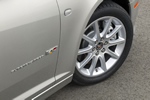  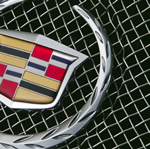 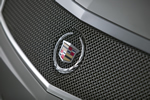 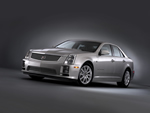 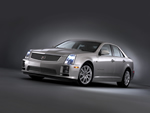  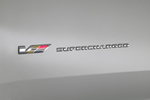  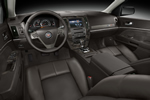 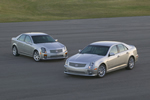 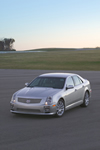 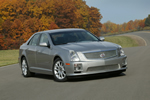 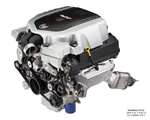 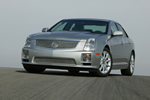 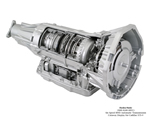  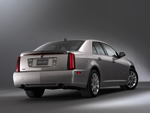 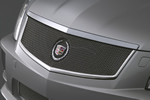 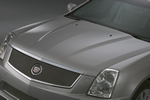 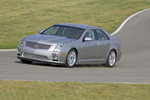  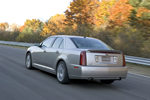  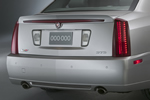 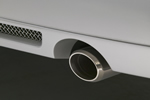 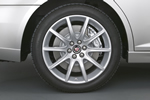  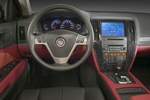 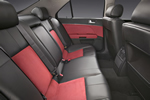  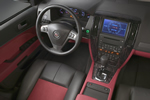  |
Discuss this article on AutomotiveForums.com
© Copyright 2006 by AutomotiveArticles.com
Top of Page
|
|
 |
|

 AF Project Vehicle | Corporate
AF Project Vehicle | Corporate



 AF Project Vehicle | Corporate
AF Project Vehicle | Corporate

